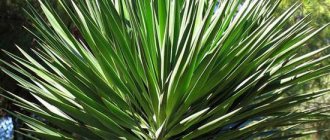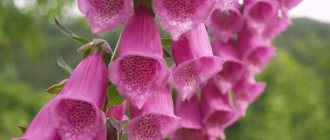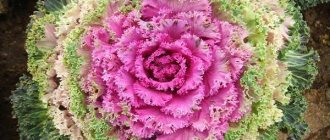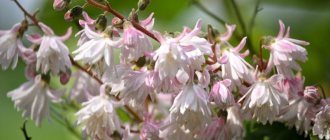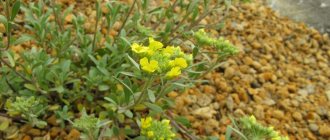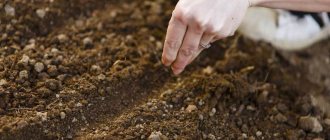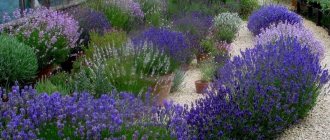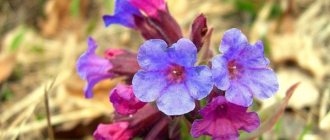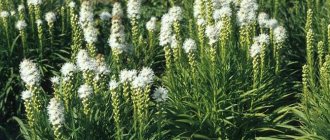Description
Campsis belongs to the genus of the same name in the Bignoniaceae family. This large, fast-growing vine, reaching 10-15 meters, is cultivated for its colorful flowers. They are odorless, form short paniculate inflorescences of 10-15 pieces and produce a lot of nectar, which attracts insects.
Bright and beautiful flowers of the plant
Campsis is mainly grown in the southern regions, although it can withstand temperatures as low as -20 °C, and even as low as -25 °C. The plant is distinguished by its decorativeness, vitality and resistance to unfavorable urban conditions.
It tolerates gas pollution, dust and other environmental pollution, can grow in the shade, but blooms better in well-lit areas.
Campsis leaves grow up to 20 cm. They consist of 9-11 small elongated leaf blades, which are dark green, up to 6 cm long and have jagged edges. The decorative effect is provided by large tubular, funnel-shaped flowers, which is why this plant is valued. They reach 9 cm in length and 5 cm in diameter.
There are many varieties with flowers of different colors. They come in yellow, pink, yellow-orange, crimson and red-golden. But the most common varieties are orange and orange-red in color.
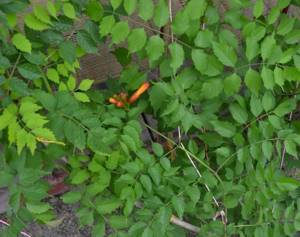
Plant leaves
The first flowers on the flexible stems of this vine begin to bloom in mid-June, and Kampsis continues to bloom until September. Sometimes this plant is called by its second name - tekoma.
The genus includes only two species: Campsis grandiflora and rooting.
taking root
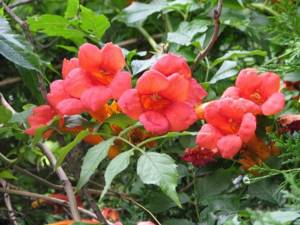
Campsis rooting The homeland of this vine is North America. It was from there that it was brought to Europe, where it has been grown in gardens and parks as an ornamental plant since the 17th century.
The vigorous vine has small, pointed, toothed leaves and blooms profusely with large, tubular, orange-red flowers. It is fixed to the supports using aerial roots.
Large-flowered
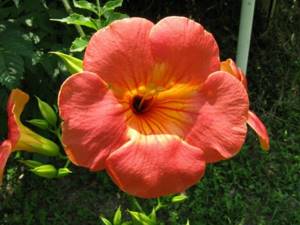
Campsis grandiflora The homeland of this species is the Far Eastern region, namely Japan and China, where the vine is found in natural growing conditions. The large-flowered variety is more heat-loving and less hardy than the rooting variety.
This liana has a second name - Chinese campsis, and is practically never found here. It is mainly cultivated as an ornamental plant in India, Pakistan, Vietnam, Taiwan and some other regions of Southeast Asia.
Hybrid
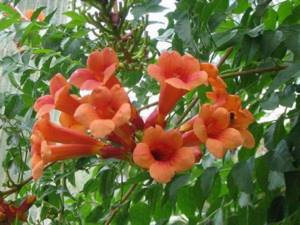
Campsis hybrid There is also a hybrid of the two above species, which is called Campsis hybrid. It looks more like a fast-growing spreading shrub than a vine.
The plant reaches a height of 4-6 meters and practically does not need support. The hybrid was first described 160 years ago, and this plant has been successfully grown in culture for more than 130 years.
Description and characteristics of culture
The genus Campsis, part of the Bignoniaceae family, are woody deciduous vines characterized by very rapid growth - the length of shoots increases by 1.5-2 meters per year. While the stem is young, it bends easily, has a greenish color, then with age it becomes brownish, the flesh becomes woody. The branches cling to the support using aerial roots or shoot tips. As the root system grows, it occupies a large area and goes deep, so the plant cannot be planted close to a building - the roots can damage the foundation.
Related article:
Campsis - vine for fences and walls

The name of the genus comes from the Greek word “kamptein”, which means to twist, bend - the stamen filaments of the flower are strongly twisted. In European countries, culture appeared in the 17th century.
The long (up to 20 cm) opposite leaves of a lush green color consist of 7-11 small leaves with a finely toothed edge. Their color lasts until autumn, and the bush looks decorative not only during the flowering period.
Large long (9 cm) wide (4-5 cm) flowers of a tubular shape, reminiscent of a megaphone, are collected in a loose panicle inflorescence. Their color in natural forms is red-orange, while in varieties and hybrids the palette is more diverse - raspberry-purple, golden, pink, bright shades of yellow. Flower buds form on the current year's shoots. Campsis blooms abundantly and for a long time - from July to September. The flowers have no aroma, but they produce a lot of nectar, which attracts insects and bees. In old bushes, the flowers become smaller, which signals the need to rejuvenate the plant.
Related article:
Pericallis plant: photos, types, growing from seeds, planting and care
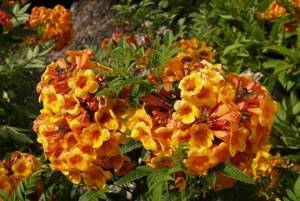
After flowering, leathery pods are formed, filled with a large number of seeds with wings. The seeds, thanks to the wings, are carried around the area by the wind. In order for a pod to form, there must be another campsis nearby.
Reproduction
Campsis reproduces easily. Among the methods are propagation by seeds, layering, root shoots and cuttings . Let's look at each of them in more detail.
Seeds
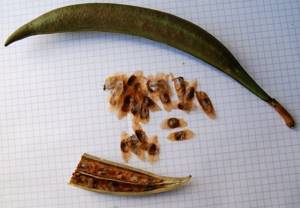
Plant seeds
After flowering, fruits are formed on the plant in the form of elongated bivalve pods, in which seeds ripen . They are sown in March in a container with substrate. To do this, grooves are made in it, having a depth of no more than 0.5 cm.
After sowing the seeds, the furrows are covered with sand. Shoots usually appear after 3-6 weeks. After 5-6 leaves appear, the plants can be planted in open ground.
This method of reproduction is used extremely rarely. Plants grown from seeds begin to bloom only at 7-8 years. Vegetative propagation methods are most often used.
Root shoots and layering
Campsis produces numerous root shoots that grow very quickly . Sometimes it appears at a fairly large distance from the mother plant, which is up to several meters. This shoot is dug up in the spring along with part of the root and planted.
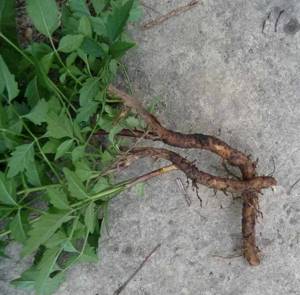
Layerings
This method of reproduction is the fastest and easiest. Young plants bloom already 2-3 years after planting. You can also propagate Kampsis by layering, but, as a rule, if there is a large number of young shoots, there is no need to use this method.
Cuttings
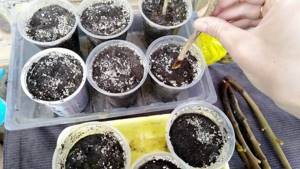
Propagation by cuttings
With this method, in June-July, Kampsis cuttings without buds are prepared and planted in open ground or pots with sandy-peaty soil.
The survival rate of such cuttings is very high: almost 90% of the shoots take root. After roots appear, young plants can be planted in open ground.
Problems possible during cultivation
Sometimes, even if all the rules of agricultural technology are followed, the buds do not set and, accordingly, flowering does not occur. This is due to the wrong choice of location (strong drafts, shade or partial shade), frosts that damaged the flower buds, and the wrong choice of variety (not suitable for the climate of the area).
Flowering of Kampsis grown from seed begins at 7-8 years, after planting the cuttings - two or three years later.
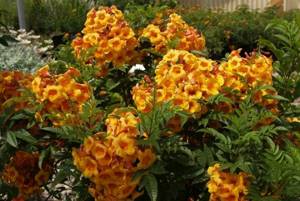
Frequent watering beyond the norm causes water to stagnate between the roots, which causes a fungal disease - root rot. When primary signs appear (softened dark base of stems, moldy soil, “wet” small spots on the surface of the leaf), you need to sharply reduce the amount of watering, then, after ½-1 month, water with a weak solution of manganese or fungicides (Bayleton, Maxim, Previkur, Alirin -B), dissolving them in water.
Of the insect pests, aphids most often settle on vines, choosing tender young leaves, buds, and shoot tips for colonies. Treatment every two weeks with a decoction or infusion based on strong-smelling plants (garlic, onion peels, tobacco, pine needles, citrus peels, tansy, etc.) will prevent their appearance. Insecticides Inta-Vir, Aktara, Komandor, Iskra-Bio will help in the fight against an already established pest.
Related article:
5 varieties of Fallopia for your garden: Secrets of cultivation
Choosing a landing site
The plant is light-loving, and for its planting it is necessary to allocate a warm and sunny area. Campsis grows well both in open places, protected from the wind, and in partial shade.
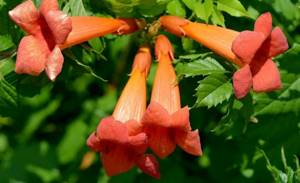
Flowers attract bees
When choosing a site where this vine will grow for many years, you should consider two important points:
1Firstly, Kampsis flowers produce a lot of nectar, which attracts a large number of insects. There will be many bees, wasps and hornets flying around the flowering plant. Therefore, the proximity of this vine to the windows of residential premises is undesirable.
2 Should not be planted near the walls of houses, brick or stone fences. As the liana grows, it puts down powerful roots, which over time can even damage brickwork or stone garden paths.
The correct choice of planting site is of great importance, and in different climatic zones the requirements for the site are different. In regions where there is not enough heat, the soils warm up slowly in the spring, and precipitation falls evenly and in large quantities, areas that have a slight slope to the south, southwest or southeast are allocated for planting campsis. Such places receive much more heat.
In areas that are located in the lower parts of the relief, plants tend to suffer from cold night fogs. In the absence of wind, moisture particles condense and accumulate in the lowlands near any obstacle, for example, near a solid barrier.
In these areas, even such undemanding plants as campsis will develop poorly. Under these conditions, heat-loving vines can be affected by fungal diseases, which often lead to plant death.
In the southern regions, where precipitation in the summer months is very uneven and insufficient, it is necessary to choose areas on flat terrain for planting Kampsis. It is better to give preference to loamy soils, which are considered more moisture-intensive.
Areas with high groundwater levels are not suitable for planting. After heavy rains, moisture will rise to the soil surface and stagnate for several days. This will adversely affect the growth and development of plants. Wetlands should also not be used unless they have been drained first.
Types and varieties of Campsis
This flowering vine has been cultivated in Europe for about 300 years. It should be noted that the genus Campsis has two species, differing in shape from each other. From them, using selective selection, hybrids were bred that retained all the main characteristics and were bred exclusively for flowers. Let's look at each genus separately.
Campsis rooting
Its homeland is the North American continent, where it can be found in the wild. A large plant, reaching a length of up to 12 meters. It has aerial roots, with the support of which it is fixed on supports. The odd-pinnate leaves reach 20 cm in length, they are darkish above and light below. Rarely pubescent over the entire surface of the lower part, or thin hairs are located partially along the veins of the leaves.
The flowers have a tubular-funnel-shaped configuration with a length of up to 10, a diameter of up to 5 cm. The corolla is orange in color and ends with bright red flaps. Flowers in the amount of 10-15 pieces are concentrated in the upper part of the shoot. Flowering occurs gradually. This allows the vine to remain elegant until autumn. Based on this genus, the following varieties were bred:
- Fabulous . In appearance it looks like a shrub with thin and rather long branches with orange-red flowers;
- Flamenco . Campsis has bright orange-purple flowers and can bloom until frost;
- Early . It got its name because flowering occurs almost a month earlier than other varieties. It has all shades of red: scarlet, porphyry, red;
- Golden . Blooms with beautiful yellow bright flowers;
- Dark purple . It has all the characteristics of the original species, but the flowers are large and their color is purple;
- Judy . Campsis is a vigorous vine. Its length reaches 15 meters or more. The characteristic features correspond to the rooting genus. It has an original coloring of flowers - an orange neck and bright yellow lapels.
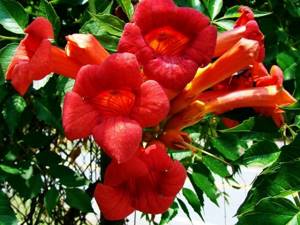
Campsis rooting Flamenco
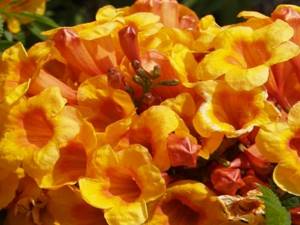
Campsis rooting Judy
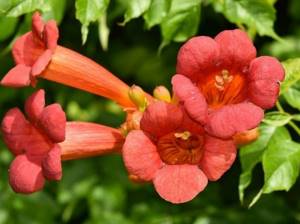
Campsis rooting Magnificent
Large-flowered (Chinese)
The basic species is found naturally in Japan and China. The main difference from the rooting Campsis:
- absence of air roots;
- less resistant to cold;
- flowers larger than those of its fellow, yellow-orange shades;
- The vine is not long, so it mostly looks like a bush.
For other characteristic features it is identical to the rooting genus. Its peculiarity is the massive blooming of all flowers. The bush is almost completely covered with flowers. The duration of intensive flowering is a month-long period, after which rare flowers appear on the vine.
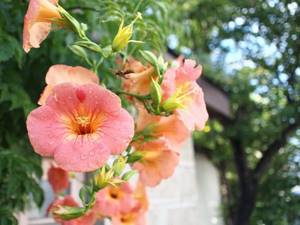
Campsis grandiflora (Chinese)
Hybrid
For the most part these are shrubs, but there are hybrid Campsis vines with large flowers of different shades. Adapted to cold climates.
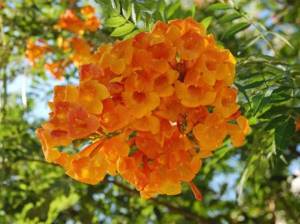
Campsis hybrid
Landing

Planting and caring for the plant
The plant can be planted both in spring and autumn. In the southern regions, autumn planting is preferred, and in the northern regions, spring planting. An ornamental liana is a perennial plant that will be grown in one place throughout its entire life span, which is often several decades. That is why the landing site must be carefully prepared.
Planting holes are usually dug 7-10 days before planting. For spring planting, holes can be prepared even in the fall. The size of the planting holes depends on the age and size of the seedlings. As a rule, the distance from the walls of the pit to the roots or earthen ball should be at least 15-25 cm. The pits are prepared with a diameter of 40-60 cm and a depth of 40 cm.

Campsis in the planting hole
The planting site should be cleared of perennial weeds and filled with organic and mineral fertilizers. On heavy loamy soils, you can make a drainage layer of broken bricks, stones and other materials that line the bottom of the planting hole. Potassium, phosphorus fertilizers and compost can be added to the soil.
It is better to plant Kampsis in a leafless state. In southern regions with warm and long autumns, preference is given to autumn planting.
It is produced in October-November, since in the fall the planted plants find themselves in the most favorable conditions for rooting, namely:
- high soil and air humidity
- moderate positive temperature
These conditions promote the rapid formation of new roots and ensure their contact with the soil. In spring, such plants begin to grow earlier and develop well in the first growing season.
If planting is carried out without a clod of earth, then pour soil into the center of the dug hole almost to the top edge and install a support. The roots of the plant are placed on the ground and straightened in different directions.
The root collar should be located 5-10 cm above the soil level. After falling asleep, settling and compacting the soil, it will be at ground level. Planting too deep negatively affects air flow to the roots. In this case, the plants will develop poorly, produce short growth and will not bloom for a long time.
When backfilling, the seedling is periodically shaken so that soil particles fill the gaps between the roots. After the hole is filled with soil, it is well compacted, starting from the edges. This is done carefully to prevent damage to the roots. After planting, the plant is watered and tied to a support. The tree trunk circle is sprinkled with soil and mulched with peat.
Growing in open ground
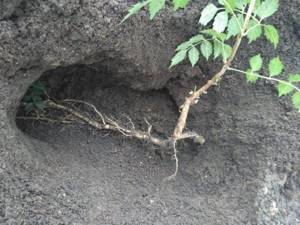
The process involves compliance with established planting rules and further care: watering, loosening, weed control. Proper cultivation and care of Campsis will bring satisfaction to the gardener with the gorgeous appearance of the plant.
Landing rules
In order for the planted seedlings to grow and develop well, you need to pay maximum attention to the flower. It will answer you with thick, beautiful foliage and massive flowering. The key to this is neutral or slightly acidic soil. Planting and caring for Kampsis is carried out according to established rules. If the soil is poor in the autumn, a special hole with a diameter of 0.5 and a depth of 0.6 m is prepared. The principle of its construction is quite simple:
- Drainage. When performing this, a gravel mixture consisting of sand, gravel and expanded clay is poured onto the bottom.
- Humus - 5 kg is poured into the hole.
- Complex mineral fertilizer – 500 ml, which is carefully mixed with organic matter.
Cover with soil, which should rise like a mound and leave until spring. In April, after the frost has passed, seedlings are planted in a hole. If the soil is normal, it is planted directly into the ground at a 45 degree angle.
Watering
Under natural conditions, the vine can remain without water for a long time, but for good flowering it needs regular watering, especially in the absence of rain for a long time. This condition is mandatory. Despite the fact that this plant is drought-resistant, without regular moisture consumption it will not bloom profusely.
Feeding
On fertile lands, Kampsis does not need feeding. But on poor soils it will be needed. Nitrogen-phosphorus fertilizers are suitable here. It is their addition that will ensure strong flowering.
Trimming and shaping
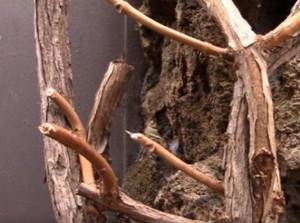
The plant is prone to strong growth. Therefore, here we need to regulate its growth and its spreading in width. Peduncles form on new branches, so the old ones are removed. This will provoke a massive appearance of Campsis buds in the spring. In addition, pruning will give the vine the desired shape. The pruning technology is as follows:
- On a young vine, two or three developed shoots are selected. Others are removed with pruning shears;
- they are secured to the support in the correct direction;
- This procedure is carried out for several years until the trunk is formed to the desired size.
Later, woody branches and several young ones are left. Three buds are preserved on them, the rest are cut off. When pruning Campsis it is possible to create any shape.
Loosening, mulching, weeding
These gardening tasks are essential for all plants. When loosening, oxygen enters the soil. If you do not control weeds, which absorb nutrients from the soil, then the area will look sloppy. Mulching helps retain moisture in the soil.
Bloom
In order for the Campsis plant to bloom in the second or third year, it is necessary to plant it with cuttings. After the roots appear, plant it in a special hole prepared according to the principle described above. During the flowering period, faded branches are removed. This will stimulate the formation of new inflorescences.
Preparing for winter
This procedure is similar to preparing grapes for wintering. To carry it out you will have to remove the vine from the supports. Tie the lashes, lay them evenly on the roots, cover them with spruce branches on top or cover them with a thick layer of sawdust and fallen leaves. Cover everything with film, on top of which fir branches are laid or covered with earth.
Growing
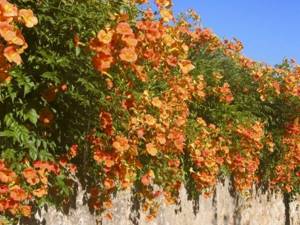
Campsis is an unpretentious plant
In terms of unpretentiousness, endurance and vitality, Kampsis, perhaps, has no equal . Even novice gardeners can safely take on growing this plant.
As noted by the owners of garden plots where this perennial vine grows, in part it can even be called aggressive due to its numerous and fast-growing root shoots.
Temperature
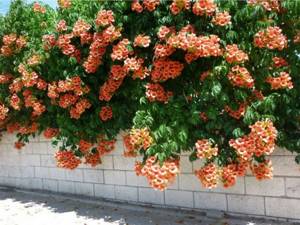
Campsis is a heat-loving plant.
Campsis can withstand temperatures dropping in winter to -20-25 °C. Despite such frost resistance, this vigorous vine is a heat-loving plant. It is the heat-loving nature that prevents the wide spread of this plant, which grows well and blooms luxuriantly in mild climates.
In colder conditions, the vine can also be grown, but in this case it will need to be provided with shelter for the winter. In regions with too low winter temperatures and harsh weather conditions, Kampsis is not cultivated.
The soil
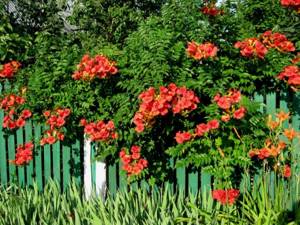
The plant has no special requirements for soil
The plant is unpretentious and has no special soil requirements. It can grow even on heavy loams, but still responds well to fertile soil, for example, humus.
It is advisable that the soil on the site is not acidic or too wet. Excessive moisture can cause rot to develop on the plant's roots.
Watering
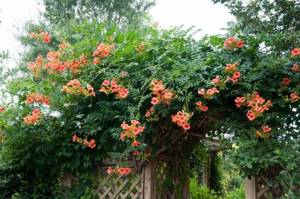
Adult Kampsis easily tolerates drought
”
- in the first two decades of May, plants are watered at intervals of 3-4 days
- from the end of May to the first half of June - with an interval of 5 days
- in the second half of June and July - once a week
[/wpsm_list]
During the hot summer months, the frequency of watering should be left unchanged, and the water rate should be increased. In this case, it is necessary to avoid waterlogging and stagnation of water, as this can lead to negative consequences for the campsis.
Between waterings, the plant responds well to a refreshing “shower” from spray nozzles with fine sprays in the morning or evening. As a rule, starting in August, regular watering is stopped, however, if the weather continues to be warm during the autumn months, it should be done occasionally.
” ]
Loosening, mulching and weed removal
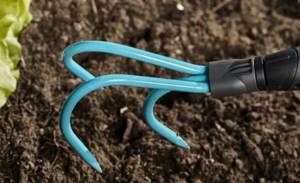
Loosening the soil should be regular
It must be remembered that watering leads to soil compaction. For this reason, plants require regular loosening of the soil. It promotes better air penetration to actively growing roots. Weeds should be removed periodically during the growing season.
Mulching not only protects the root system from overheating and improves aeration, but also helps retain moisture in the soil. This allows you to water the campsis less often without compromising the moisture supply of the plants. You can plant several low-growing perennials near the vine trunk. They will shade the roots and cover the bare parts of the shoots.
Feeding

Nitrogen-phosphorus fertilizer
In the first year, fertilizing, as a rule, is not carried out , since the root system of the plants is not yet sufficiently developed, and the vines receive all the necessary nutrition from well-filled planting holes.
Such care ensures intensive development of the root system, good annual growth in the first year after planting and subsequent penetration of roots into deeper soil horizons.
Adult plants do not need fertilizing. However, for long and lush flowering, you can fertilize the vine with nitrogen-phosphorus fertilizer at least once during the spring-summer season. In this case, an abundance of bright colorful “gramophone” flowers on the shoots of Kampsis will be guaranteed.
Pruning and crown formation
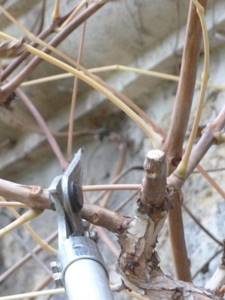
Pruning Kampsis
During the flowering period, it is necessary to remove all faded flowers from the Kampsis shoots. Regular removal of them allows you to prolong the flowering of the vine. Abundant flowering is also promoted by rejuvenating pruning, which is carried out by removing and shortening old stems before the start of spring.
Campsis grows at a very fast pace, and the annual growth of vines can reach several meters. For this reason, pruning is extremely necessary for the plant. Like most vines, Kampsis tolerates this procedure quite steadfastly, which is carried out in the spring, before the buds open.
If desired, the plant can be given a certain shape using formative pruning. If Kampsis grows as a hedge, then fast-growing shoots should be pruned 2-3 times during the summer.
Aging plantings are pruned in autumn or spring to rejuvenate and stimulate vegetative growth, since flowers appear only on young shoots. To do this, severe pruning is carried out, leaving only woody stems.
In addition to rejuvenating and formative pruning, they also perform sanitary cleaning of the crown. This operation is carried out to remove dry, dead and damaged shoots. In addition, after pruning, it is easier to prepare the vine for winter.
Preparing for winter
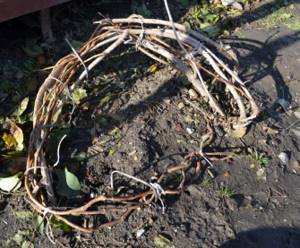
Preparing for winter
Campsis can withstand short-term temperature drops to -20-25 °C.
However, if low temperatures persist in your region for a long time, the plant should be covered with insulating materials for the winter. Cover both the roots and shoots of the plant.
To do this, before the onset of cold weather, you need to remove the shoots from the supports, tie them and tilt them to the ground. The top of the vine is covered with a thick layer of spruce branches, and a film or agrofibre is placed on top of it.
Possible problems in growing:
Liana is a completely unpretentious plant, but sometimes the gardener has to face some difficulties. These are diseases, pests, lack of flowering or slow development.
Pests
The liana is interesting only to aphids, which periodically attack the flowers. To get rid of the parasite, the plant must be treated with insecticides. For prevention, these funds are used in June.
Diseases
Due to excessive watering and constantly high humidity, root rot can occur. To restore the plant, it is necessary to remove damaged parts of the root system and normalize watering.
Additional Information! Liana flowers have virtually no scent, and bees are attracted to the very sweet nectar.
Signs of improper care
Lack of mulching, which causes the roots to overheat, excessive watering or lack of moisture - all this leads to the fact that the vine develops poorly. She rarely has shoots; they are very weak. Flowering is weak and short-lived, the color of the flowers is faded. The leaves turn pale and wither.
Campsis is a beautiful liana, which is loved for its active elongation of shoots and bright, long-lasting and abundant flowering. Caring for it is not at all difficult, and therefore even a novice gardener can use it to decorate the walls of a house, gazebo, or veranda.
Diseases and pests
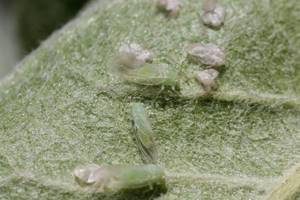
Aphid on a leaf
Campsis is a plant that is resistant to many pests and diseases. With proper care, this vine gets sick extremely rarely, and even pests are not particularly interested in it.
With excessive watering, rotting of the roots can occur, and the only insects that cause trouble for the campsis are aphids.
In dry weather, these small pests, together with their larvae, can accumulate on the leaves of young shoots and stick to flower buds.
You can get rid of them by spraying the plants with a solution of laundry soap, an alcohol solution, or chemical pest control agents. Chemical treatment of the plant should be carried out with means that do not pose a danger to people.
Use in landscape design
Campsis is widely used for vertical gardening of fences, building walls, gazebos and arches. Buildings on your site will look very decorative if they are covered with climbing plants, and campsis is perfect for this purpose.
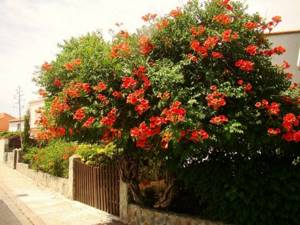
Campsis in landscape design
With the help of this vine you can disguise nondescript outbuildings and give an attractive appearance to a blank fence. The plant can also be grown as a small tree, giving it a standard form.
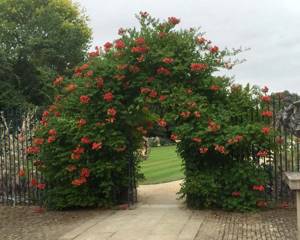
Kampsis arch
Kampsis is also used as a hedge. It will grow, bloom and bush on its own, and all you have to do is trim the thickets of fast-growing shoots. A hedge will be an excellent option if you need to hide a recreation area on your property from prying eyes, but you don’t want to build a stone fence or erect a brick wall for this.
A hedge made of Kampsis will protect from dust, reduce extraneous noise and become a beautiful backdrop for other plants. With its help you can create a cozy place to relax.
To create a hedge, you can use two options:
1Formable hedge. Such hedges undergo regular trimming and crown shaping to achieve the desired size and shape.
2Unformable hedge. These shrubs grow freely without human intervention.
Since Kampsis is a vine, it needs support . In order to make a hedge from this plant, you can put up a chain-link fence and form a hedge on it. In the warm season, and especially during the flowering period, this element of landscape design will look very picturesque and attractive.
